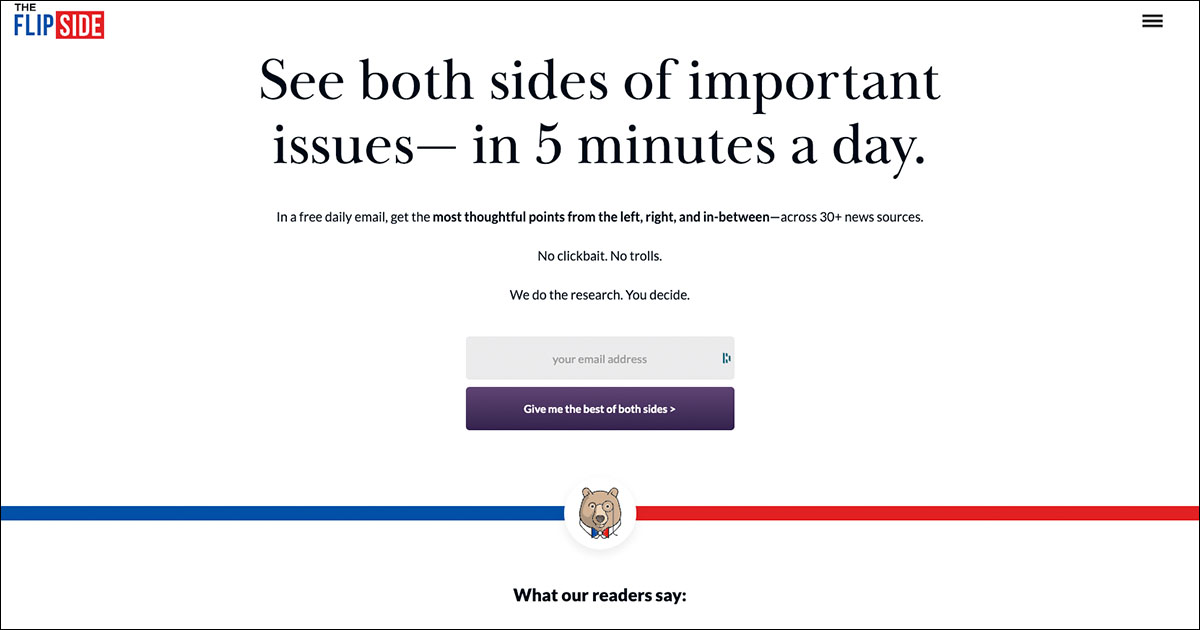Fighting Polarization, One Person at a Time
The Origin Story of The Flip Side

Last Updated: By TRUiC Team
If there’s one thing we can all agree on, it’s that we don’t agree on much. It seems like political polarization is getting worse by the month, and it’s becoming harder to understand each other’s points of view — or even talk to each other in a civil manner.
The Flip Side wants to flip that script by providing curated news content that accurately and fairly presents both the conservative and liberal sides of major issues of the day. The goal is to help people defend their own points of view while promoting mutual understanding and respect. This is The Flip Side’s origin story.
From Finance to Founder
Annifi says she got into finance after college because “she didn’t know what else to do with her life,” had student loans to pay off, and was a “high achiever.” She climbed the ladder at Ernst & Young but eventually realized it was leaning against the wrong wall. That led her to go work for Hilary Clinton’s 2016 presidential campaign.
“I mostly just wanted to play my small part in helping elect the first female president,” she says. “Things did not work out that way, and I think I started Flip Side honestly as a coping mechanism. Right after the election, I was reading so much … and talking to every Republican conservative … Bernie supporters, anyone I could think of to help me make sense of how it led to such a surprise election result in 2016.”
She eventually met the person – a “staunch conservative” – who co-founded The Flip Side with her as a side project. The newsletter started small, but after some media appearances, the subscription base grew large enough that Annifi decided to make The Flip Side her full-time job. “[We recognized] that we were fulfilling this really important need, and I was looking around, and no one else was doing what we were doing. And so that's how the newsletter took off.”
Getting America ‘On the Same Page’
Annafi says she believes if people just understood where others were coming from, we all would be more tolerant of other viewpoints and less inclined to think the worst of those who hold them. That, in a nutshell, is what she’s trying to accomplish with the company’s newsletter, which hits subscribers in boxes five days a week.
“We focus on one topic a day, and we fact-check and curate the best arguments from both liberal and conservative media,” she says. “We're reaching a quarter million people via the newsletter, and we just launched a new platform … The idea of the new platform is that it's a Salon to Twitter's town square. So instead of the cacophony of, you know, clickbait headlines and trolling, you see, we are actually designing the algorithm, user incentives, the business model, Everything to highlight by partisan, by partisanship and compromise.”
Although it may seem like a tall order for one newsletter to bring people with wildly divergent viewpoints together, Annafi doesn’t shy away from the challenge because the problem is only getting worse.
“Right now … half the country is reading The New York Times [and] watching CNN. The other half is watching Fox News [and] reading National Review or The Wall Street Journal,” she says. “And we are just literally not on the same page until we're faced with the worst Twitter thread that's gone viral. Or maybe we see our uncle at Thanksgiving once a year when he is giving us talking points we haven't heard outside of late-night TV or something. And so our goal is to create that shared new source that shares reality for liberals, conservatives, moderates, the apolitical. Literally, get America on the same page.”
Controlled Experiment, Learning by Doing
The Flip Side has several projects on the horizon, one of which is to conduct a controlled experiment to try to discover new ways to decrease political polarization. The goal is to show that its product can work, which hopefully will attract further investment.
“One thing is we have a John Hopkins researcher, and we are co-applying for a grant with Stanford, where we will allow people to enter into the forum for a three month free period and there will be a control and experimental group,” Annafi says. “We're going to test one of… our many hypotheses around how to decrease polarization and do semantic analysis and see how the interactions go to see if our form and our intervention is actually… scientifically significant in terms of decreasing polarization. So getting that … research study and showing and proving that our methods work will be really valuable, and I think very attractive to investors as well.”
Annafi offers this piece of advice for early-stage startup founders: It’s important to get out there and actually apply things you’ve learned.
“You will learn faster by doing than … reading a hundred books,” she says. “There are a whole bunch of books you're supposed to read, and you should, but also just jump in. Send that newsletter to sixteen people you know. Send that cold email, cold DM, what have you. You just have to do things, try things, put yourself out there. It's going to be really hard, and don't be afraid to ask for help.”
Tell Us Your Startup Story
Are you a startup founder and want to share your entrepreneurial journey with our readers? Click below to contact us today!


